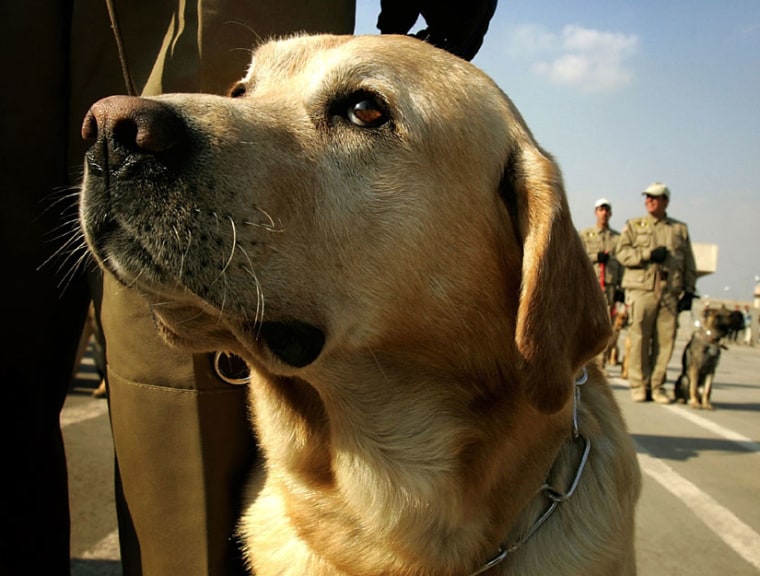From infantry units to secret SEAL teams, the U.S. military is using increasing numbers of dogs and robots to assist in conflicts across the world.
Long valued by soldiers for their keen senses and tracking abilities, dogs have been used in war since Roman times. Now man's best friend is going into combat zones wearing high-tech bulletproof vests, parachutes and video cameras. Meanwhile, rolling robots are getting stronger, smarter, smaller and — someday soon — will be equipped with their own weapon systems.
So will robots ultimately hold the title of a soldier's (or Marine's) best friend? Or can nothing replace the trusty canine?
Well, Jeff Jaczkowski, deputy project manager at the Robotic Systems Joint Projects Office, says he's trying to make robots more dog-like.
Jaczkowski tests and evaluates all ground-based robots used by Marines and soldiers in Afghanistan and Iraq — more than 2,000 altogether. He's also a dog owner and a hunter.
"We are working with our lab partners to increase onboard intelligence and intuitiveness between robot and the soldier," Jaczkowski said.
He says that dogs currently have the upper hand when it comes to smarts, mobility and endurance, while robots are pretty darned strong and, of course, replaceable.
"Dogs have a vocabulary of 100 to 200 words," Jaczkowski said. "They respond to hand gestures, like a bird dog with a point, all that interaction occurs between the handler and the dog. That is where I believe we need to get ground robot systems to enable that soldier-robot teaming to get to that level."
Jaczkowski said engineers are working on developing speech recognition, gesture recognition and artificial intelligence for combat ground robots. A pilot program in Iraq a few years ago devised a heavy machine gun mounted on a robot vehicle, but safety fears killed the plan before it was operational.
The biggest complaint he hears from troops in the field is that ground vehicles can't make it down steep slopes (exploring culverts is really tough) and have a limited range — usually up to a kilometer. They also have a finite battery life. Dogs just keep going.
"The warfighter is always asking for smaller and lighter, but they always want (the robot) to do more," Jackowski said. "There's a point where engineering and the laws of physics meet. We can't have a robot that can lift and 155-caliber round and go for 24 hours and have it weigh only 10 pounds."
Since their advent in 2004, ground robots are now helping military demolition teams destroy IEDs and other explosives, and are equipped with special arms to pick up and remove suspicious objects. That's something dogs still can't do. But both are being sent into buildings to find enemy suspects and clear rooms.
In fact, the same military unit that raided and killed Osama Bin Laden in May is now looking for a few good dogs to help them conduct secret missions. The U.S. Navy's Special Warfare Development Group (DEVGRU — also known as Seal Team Six) put out a public notice this week looking for private firms to provide an encryptable video camera that can be carried by dogs. There were reports that a Seal Team Six dog named "Cairo" was used in the Bin Laden raid on May 5. An estimated 2,700 military dogs are working in Afghanistan and Iraq.
In addition to keeping enemies at bay, dogs provide a camaraderie to troops that can't be matched by a tractor-like robot that looks more like WALL-E.
"It's nice having a dog as part of a team," said Jim Slater, chief executive officer of K9 Force, a Canadian firm that makes protective gear for military dogs, including an infrared, waterproof dog camera. "Everyone learns to trust the dog for his capabilities. Dogs can operate really anywhere a human being can go, they're built for being outside."
